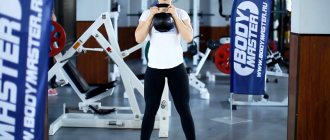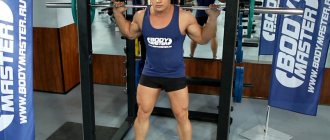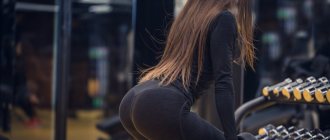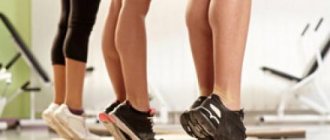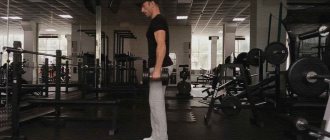Firm, rounded buttocks are an attractive part of the body for a person of any gender and age. You can deny this fact as much as you like, but animal instincts will always force us to pay attention to this “detail” of our own and others’ figures.
Everyone has different tastes. Some people like “butts like a nut”, others like round and soft ones. In recent years, there has even been a certain cult of buttocks - spherical and hard, like bowling shells. To achieve this ideal, people, especially women, are willing to literally live in gyms.
However, not everyone can train fiercely for months to achieve the perfect body. And it’s not always possible to pump up your “dream butt” with squats. If by nature a person is given one shape of buttocks, but he dreams of a completely different one, the situation cannot be corrected without outside intervention.
In such a situation, only surgery can help - buttock plastic .
1
Consultation with a plastic surgeon
2 Plastic surgery for buttock correction
3 Plastic surgery for buttock correction
Causes and mechanism of manifestation
Natural reasons:
- congenital structural feature of the buttocks;
- age-related changes;
- sudden weight gain and loss;
- hormonal changes.
External factors:
- sedentary lifestyle;
- complications of invasive interventions and plastic surgeries;
- injuries of the ligamentous apparatus of the gluteal region.
With age, the amount of collagen and elastin fibers in tissues decreases, sudden changes in weight lead to stretching of the skin and a decrease in its tone, lack of physical activity weakens muscles, and in case of injury, the integrity of the ligamentous system is disrupted. As a result, the mobility of soft tissues increases: skin, fascia, subcutaneous fat layer, they move downwards. Ptosis of the buttocks can be unilateral or bilateral.
How to determine ptosis
Severe ptosis is easily determined visually: the center of the buttocks is shifted downward, the gluteal fold tends to the outer side of the thigh. Minimal changes are not so noticeable, so there are tests to detect the presence of ptosis, the degree of its development and stage.
A ruler is used to determine the degree of sagging of the buttocks. In addition, the gluteal-femoral angle in the lateral projection is assessed.
When measuring with a ruler, it is placed under the gluteal fold. Overhang of the fold 0.5 cm below the subgluteal groove is the first degree, by 1-2 cm is the second degree, more than 2 cm is the third degree.
To assess the gluteal-femoral angle in a photograph or with the patient in profile, two lines are mentally drawn. The first is through the point of maximum convexity of the buttocks, the second is upward from the midline of the back of the thigh. Ideally, the internal angle at the intersection of these two lines does not exceed 45 °, an angle of up to 90 ° is the norm. An obtuse angle greater than 90° indicates the presence of ptosis, the stage of which increases as the angle increases.
Using special threads
Using special threads, skin flaps can be tightened. To do this, the material is injected under the skin, capturing soft tissues and ligaments. The threads have special devices on their surface (which grab the fabric and pull it along). The result is the desired effect. The advantages of this method of lifting are as follows. Firstly, no anesthesia is required; the procedure is performed under local anesthesia. Secondly, there are practically no contraindications. Thirdly, the desired result is achieved within 1-2 hours. Among the disadvantages of the method, one can highlight the instability of the resulting effect.
Stages of development: buttock ptosis test using M- and T-lines
The assessment method was developed by Brazilian plastic surgeon Raul Gonzalez. In a photograph of the patient from the back, or mentally on the patient’s body in a standing position, two vertical lines are drawn. The M line runs along the midline of the back of the thigh to the top of the buttock. The T-line connects the sacrum and the ischial tuberosity. The extent to which the gluteal fold extends into these lines is then assessed and the stage of ptosis is determined.
- Normally, the fold is absent or reaches the T-line without crossing it.
- The next stage is preptosis. It is divided into minimal (the fold crosses the T-line, but does not reach the M-line), moderate (the buttock fold reaches the M-line, without going beyond it) and borderline (the fold crosses the M-line).
- With true ptosis, the gluteal fold extends significantly beyond the M-line, tending to the outer side of the thigh.
Glute bridge on a sofa/chair/bench
In this case, a sofa, chair and any other piece of furniture are needed to increase the range of motion and increase the load.
Imagine that your favorite sofa is a fitball: place the shoulder part of the body on it. Bend your legs and fix them on the floor. The back should be straight without arching in the lower back. Then push your buttocks up. Return to the starting position. Repeat 30 times.
Ways to tighten without surgery
In the initial stage of ptosis, you can try to give the buttocks a rounded shape and lift them using non-surgical methods. Visual tightening is provided by shapewear: tight elastic shorts, bodysuits, graces. Some models add additional volume.
Fitness classes strengthen muscles and help in the fight against excess weight and cellulite. However, if ptosis is a feature of your body type, exercise will not help. Physical activity is ineffective with age-related and hormonal changes, and is contraindicated with ligament injuries.
Manual or hardware massage, myostimulation, radio wave lifting reduce body volume by removing excess fluid, smooth out the relief and improve the appearance of the skin. These procedures are useful for minor sagging of soft tissues, but will not cope with severe manifestations.
Tips from fitness trainers: how to quickly pump up firm round buttocks for a girl
Experts place the main emphasis on nutrition. Products should be as useful as possible.
Note! Exercises for a round buttock shape will be effective only when the entire diet is reviewed. Remember that fasting will never give you a rounded butt.
The important point is regularity. It is necessary, especially at first, to perform the exercises constantly. You also need to remember that all movements during training should be slow and concentrated. Speed of action will not bring instant results.
The most important point is correct breathing. When exhaling, the exercise itself should be performed, and when inhaling, the starting position should be taken.
You also need to remember about your daily routine. Sleep should be constant and average 7-8 hours. A tired person will perform many times fewer exercises, which will affect the desired result.
There are no unattainable peaks, the main thing is to strive and then everything will work out. The mindset to perform exercises to give a round shape to the buttocks is half the success. When the first results appear, an even greater incentive will appear.
Surgical correction
Surgical interventions are effective for the second and third degrees of true ptosis of the buttocks. Lifting or plastic surgery restores lost volume to the buttocks, gives them a beautiful shape, and tightens the skin. The correction method is selected by the doctor individually. The most commonly used are thread lifting, surgical lifting and gluteoplasty.
Thread correction (filament lifting, or Brazilian lift) is used for mildly severe ptosis. Under local anesthesia, threads are inserted under the skin of the buttocks using cannulas, which are fixed in the soft tissues using notches. The threads tighten the skin and subcutaneous fat and hold them in the desired position. The advantages of the procedure are quick recovery and no scars. The effect of thread lifting lasts from 3 to 5 years.
Surgical lifting provides a longer lasting effect. The operating doctor chooses the lifting method based on the structural features of the buttocks and the degree of tissue displacement. There is no universal surgical approach; the lift is performed through a median, lower, lateral or upper incision. During the operation, excess soft tissue is excised, muscles and skin are tightened and fixed. Surgical lifting can be done at the same time as liposuction and thigh lift.
Gluteoplasty – augmentation and correction of the shape of the buttocks with silicone implants. Implants come in round, oval and teardrop (anatomical) shapes. Round or oval endoprostheses are chosen when it is necessary to increase volume; anatomical implants are suitable for correcting asymmetry, deformation and other aesthetic defects. Gluteoplasty, as well as surgical lifting, can be combined with liposuction and hip shape correction.
Exercise technique
Sumo squats
This exercise is used in powerlifting, as well as by girls, to tighten the gluteal muscles and muscles of the inner thighs. The exercise will also help your legs become slimmer.
Let's move on to the squat technique:
- To begin, spread your legs wide and point your toes out to the sides. The bar of the bar, as in classic squats, rests on the back muscles.
- Inhale and, leaning forward as little as possible, squat until your thighs are parallel to the floor. Make sure that your knees bend in the direction of your toes and do not move inward. Move your pelvis back to transfer the load of your feet to the outer edges and heels.
- Then rise up and exhale.
What muscles work in sumo squats?
- Muscles of the inner thighs (adductors)
- Front of thighs (quadriceps)
- Large gluteals (due to which the shape of the buttocks and size are formed)
- Back of the thighs (hamstrings)
- And also additionally: calves, lower back, abdominal muscles
Plie squats
This is the same exercise as sumo squats, only one difference: instead of a barbell, you use a kettlebell or dumbbell, which you hold below, lowering between your legs.
Breeding legs in the simulator
What are the advantages of this exercise?
- In the process of spreading the legs in the simulator, the small muscles of the thighs are activated, which do not work in other exercises.
- Tightens the outer thighs
- Increased abductor strength
- Has a positive effect on running performance
- Has a beneficial effect on blood circulation
Deadlift on straight legs
The stiff legged deadlift is one of the most important exercises in any workout. So, now let’s look at the benefits of training in general and for the buttocks:
- This exercise places the main load on the hamstrings, buttocks and lower back.
- If you bend your legs, the buttocks are included in the work, the hamstrings are turned off and vice versa. Do not straighten your legs completely, otherwise the tendons behind the knees will be overloaded.
- For convenience, girls can use dumbbells instead of a barbell, but the weight of the dumbbells will be less than the barbell.
- Always keep your back straight to avoid injury.
- Before performing, warm up with hyperextension. If you have lower back pain, do not perform the exercise.
Technique:
- Lift the barbell and stand straight with it.
- Slowly lower yourself down, keeping your knees slightly bent, keeping your back straight, and the barbell should drop just below your knees.
Lunges
Lunges are one of the most effective exercises for round and firm buttocks. Let's move straight to the technology :
- Get into the starting position: standing, legs together, dumbbells in hands
- We move our foot forward, but putting it slightly to the side
- And we bend the second leg, but do not touch the ground with our knee
- We stand up and then change legs

